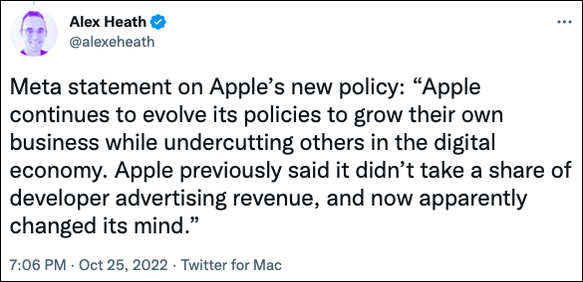
In yet another ingenious
move to assert control -- as well as its share of monetization -- over apps installed on iPhones, Apple quietly updated its App Store guidelines in a way that gives it a
cut of in-app purchases made by advertisers to “boost” their audiences on social media apps, as well as the burgeoning NFT marketplace.
While implications for the NFT
marketplace remain to be seen, the new rules mean that advertisers buying audience boosts must do so as in-app purchases, meaning Apple will get its 30% cut from social media apps, including Twitter,
as well as Meta’s Facebook and Instagram.
Not surprisingly, Meta has already issued a statement calling foul play, but much as it did with
the fallout it experienced from the loss of data signals due to the rollout of Apple’s iOS privacy framework, there probably isn’t much it can do -- other than kvetch, issue statements,
and call on other third parties (i.e., small and medium-sized businesses) to cry foul, too.
advertisement
advertisement
Apple is a walled garden too, of course. But the best part of Apple's move to control what
happens within its ecosystem is that it's always intended to a) benefit Apple users and b) Apple’s bottom line, in a way that gives the other walled gardens a taste of their own medicine.
In fact, it shouldn’t make any difference to advertisers – or consumers – who gets paid for what, so long as the price is fair, market-based and they don’t have to
pay more than they otherwise would.
I mean, who cares if Meta has to pay a vig to Apple for the right to distribute and amplify its audience reach across Apple devices?
Is it any different than Meta requiring advertisers to pay a vig to distribute and amplify its ads on Facebook, Instagram, or even worse, its own network of third-party app developers that
are forced into its shakedown racket?
Not to me.
What do you think?